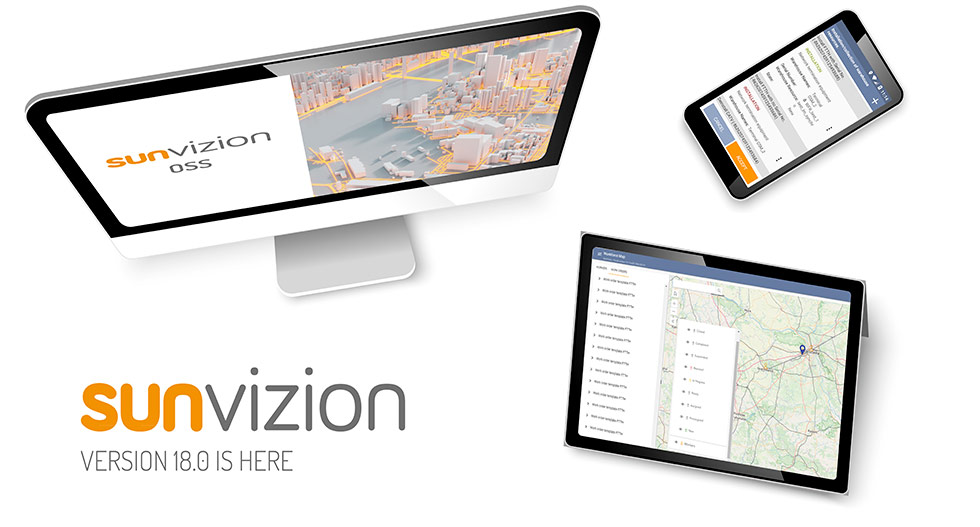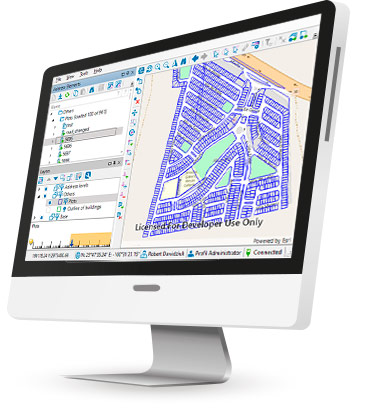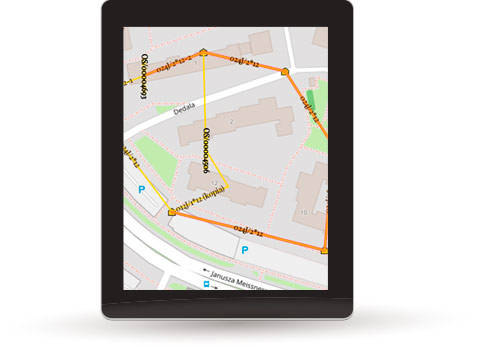We are excited to announce the on-schedule release of new version 18.0 of SunVizion.
The set of enhancements is wide ranging, providing improvements to the overall architecture (such as introducing more cloud-native components), foundational services and many application modules – including Resource Inventory, Network Planning, Logistics Management, Numbering Inventory, Service Inventory, Service Order Management and Workflow. SunVizion is now even more useful for our clients. In fact, Logistics Management and Numbering Inventory go further than that. They both have new web versions available that will supersede their current Desktop versions.


Improved Integration and Standardisation

Integration is clearly acknowledged as one of the greatest risks involved in any OSS/BSS project. If not carefully planned and implemented, they can introduce time delays as well as effort and cost blow-outs to a project budget.
Having noticed a clear trend in the industry around the increased uptake of TM Forum Open APIs, we have joined as a signatory to the TM Forum Open API Manifesto. Release 18.0 sees the introduction of the following APIs into our product suite:
- Resource Inventory Management REST API (TMF639)
- Resource Order Management REST API (TMF652)
- Document Management REST API (TMF667)
We also have another four Open APIs under development for a future 19.0 release. These new interfaces extend on an already comprehensive library of integration modules offered with the SunVizion suite.
These initial TM Forum REST APIs signal our clear strategy to make SunVizion more open via standardised integrations with third-party applications.
An Improved User Experience

Release 18.0 also represents a significant step in the ongoing journey of User Experience (UX) improvements. UX changes typically manifest as User Interface (UI) and workflow changes. Whilst the UI changes might be difficult to spot in this release, some fundamental changes have been made to the SunVizion components - for both web-based and desktop versions of our applications. Eagle-eyed users will notice some visual changes on web (third-party components) and desktop (forms and scalable fonts) interfaces in Release 18.0. Even bigger UX changes are set to come in Release 19.0 and beyond, building on the platform of structural enhancements made in this latest release.
Architecture Enhancements
A number of enhancements have been made to other underlying systems, including messaging, data management and logging, all for the purpose of improved platform performance and cloud readiness. It covers more efficient use of the AWS Cloud components and services including Amazon Relational Database Service (SQL Server RDS), S3 Bucket and Message MQ services. These improvements aren’t just apparent as enhanced user experiences (e.g. accessibility, query times), but also for system scalability, high-availability (HA), security - and monitoring.
Spatial Editing and Resource Management Enhancements

Clients that utilise the spatial visualisation and query features in Network Inventory and Network Planning modules will appreciate improved design efficiency. This has been achieved via new spatial editing capabilities including:
- Attract during polygon editing
- Modification of adjacent polygons
- Modification of polygons contained
- Polygon splitting
- Automatic grid layout for dependent objects
- Support for geometries composed of multiple figures
Release 18.0 has also introduced management of address elements via spatial data.
To speed up address selection, search and validation functionality has been improved, allowing the user to search on any part of the name, within any level in the address data hierarchy (e.g. entering a street will help the user with a pick-list to easily identify region, postcode, etc). For map-based systems, address selection is improved by automatic reverse geocoding.
The Discovery & Reconciliation tool has been enhanced to support incremental or selective import of address data from AutoCAD files. The import can be initiated after selecting a parent object based on coordinates or when contained within a polygon/s. It’s also now possible to import other parameters from CAD files too.
Address data can now be reconciled with the Network Inventory module. This allows for client notification of changes as they occur, including incremental or nested design changes (to projects or versions, known as branch versioning).
New Physical Schema Elements

A new “cable tray” schema element has been added to the physical network modelling. Resource Inventory now supports cable trays, ladders, tunnels and risers. Cables can be associated with this new element type. A cable instance can be pulled in or out of any cable tray instance at any point along its length.
New functionality, and a new “building” schema element, has also been introduced in Release 18.0. This allows clients to easily generate network designs, using pre-defined profiles for Multi-Dwelling Units (MDUs). High-rise (i.e. multi-floor, multi-apartment), low-rise, campus and sub-divided block layouts are all facilitated by this new feature.
With this feature comes new automation functionality that expedites MDU design. These automations include auto-patching to assign fibres from the ODF (Optical Distribution Frame) to breakouts per floor and then to apartments per floor, significantly reducing manual design effort. These auto allocations can be overwritten or updated as needed though of course.
Enhancements have also been made to the “Cable” schema to incorporate:
- Infrastructure duct / trench information
- Total cable length
- Rack details at terminations
The concept of “Fiber Trails” has been improved. No longer are fibers just limited to segments, but can be rolled-up to “trails” as a set of connected / spliced fiber segments. This new trail entity can have other data stored against it such as purpose, number of terminated fibers, end-to-end optical loss characteristics and more. Trails can be searched by geo-positioning, but also by the other attributes listed above. These trails can support fibers being terminated on more than one node, allowing for splitters, such as with Passive Optical Network (PON) network architectures.
New Fault Correlation Module
Release 18.0 introduces a new module that allows for faster and more comprehensive service / fault impact analysis on FTTx architectures. This new module performs what’s known as Root Cause Trace (RCT). By performing component connectivity traces across each active Trouble Ticket, this module then performs aggregated analysis to identify whether there are common possible failure points (e.g. a cable that appears in the traces related to multiple tickets is possibly damaged).
Not only does this module identify common tickets and consolidate them as problems to resolve, but it also identifies associated services and alternate routes. Service Impact Analysis (SIA) allows the operator to then inform their clients of a potential service impact. Alternate route planning allows fiber engineers to quickly execute fiber circuit transfers via patching, splicing or potentially even higher-order traffic re-routing whilst the faulty infrastructure is repaired / replaced.
Improved Web Portal
Release 18.0 introduces a new features in web portal for operators to offer to their clients. Functionality wit hin this module includes:
hin this module includes:
- Service Qualification (SQ) and resource reservation pending a customer order
- . This point alone can introduce significant time savings, particularly for clients that are making fundamental changes to their outside plant architectures. A common example is for an industry that is now pushing fibre deeper into their networks and/or expanding available capacity for their customers. The system does this by checking the resources / network / configuration and automatically prepares the detailed design for the new engineering standards (eg the introduction of new splitter patterns) on a separate version, ready for review and approval by the designer
- Resource visualisation on a map overlay, allowing for:
- Trails to be queried, identified and traced
- Create new resources in an actual / planned geo-location
- Create cable / duct reserves
Network Planning Enhancements
We’re excited to release a number of new features in our Network Planning solution. The following features are eagerly anticipated by clients that heavily utilise this module:
- The introduction of custom project attributes and forms, increasing the flexibility of the module to cater for specific client data-capture needs
- Improvements to automated project / design documentation generation, including maps, infrastructure / cable schemas and manhole diagrams
- Improvements to the automated BOM (Bill of Materials) and cost / quote generation functionality
- Merge / Post conflict solving improvements, which avoid errors when multiple network planners are working on projects / versions simultaneously where resource associations or dependencies exist
- Resources reservation in main version for planned usage in planning versions
New Logistics Management Web Module
This release has introduced a new web version of the Logistics Management module. It offers the same full functionality as the superseded Desktop version, but also allows operators to search for any resource by serial numbers or bar codes.
Numbering Inventory Enhancements
A new web version of the Numbering Inventory module is included in this release. The web version offers the same full functionality as the superseded Desktop version, but also introduces integration with the new Numbering Inventory web module, allowing operators to:
- Assign numbers and sub-ranges to multiple resources
- Define operators and IP networks
- Search by numbers, sub-ranges and more
The functionality offered by the superseded desktop version of Numbering Inventory has been included (and enhanced) in this new web version, allowing operators to:
- Group numbers / sub-ranges and assign them to multiple resources
- Easily search for subnetworks
- Edit number and subrange state
- Review sub-range numbers / hierarchies and assignment
Service Inventory and Service Order Management Enhancements
Improvements have also been made to add greater flexibility in the decomposition of Service Orders, Resource Facing Services (RFSs) and Customer Facing Services (CFSs) using python scripting.